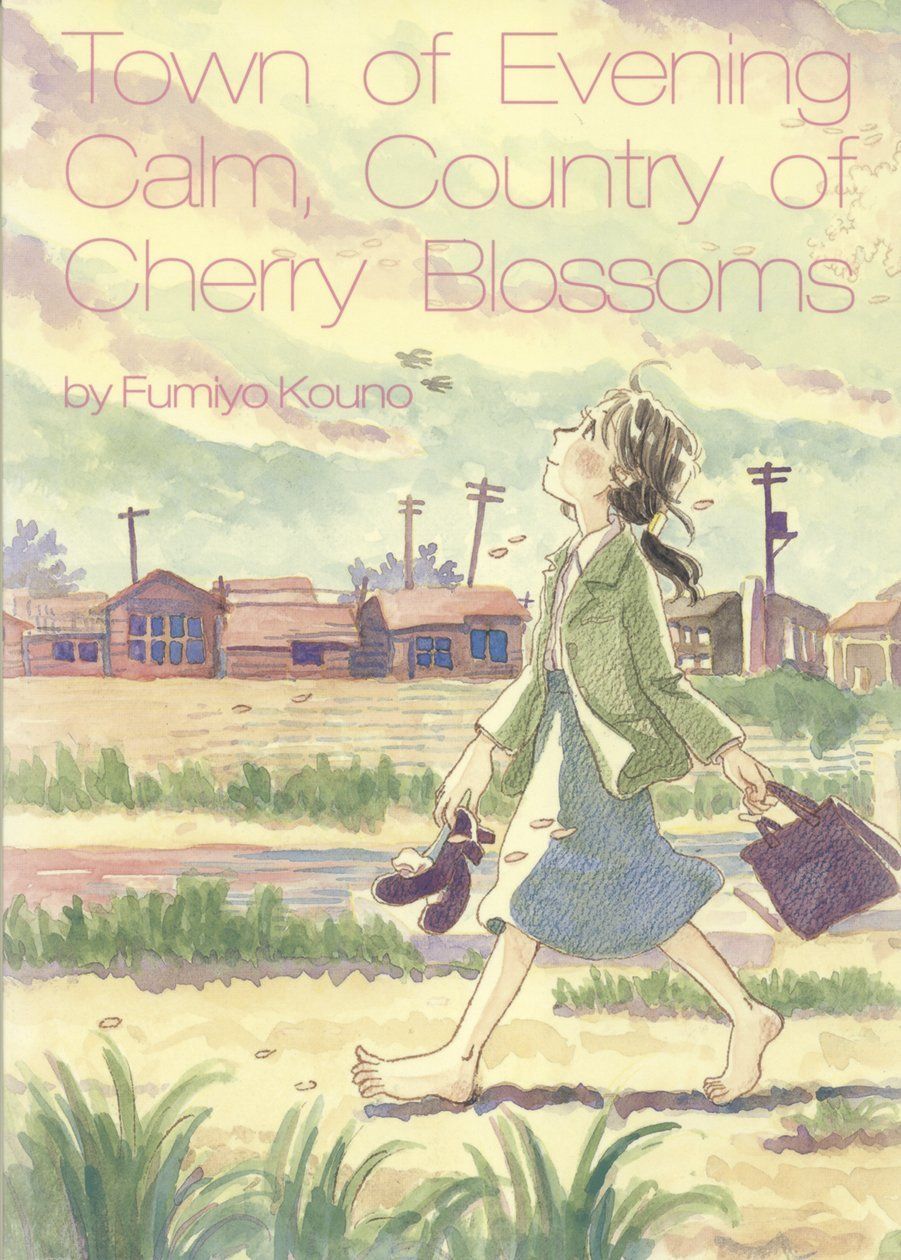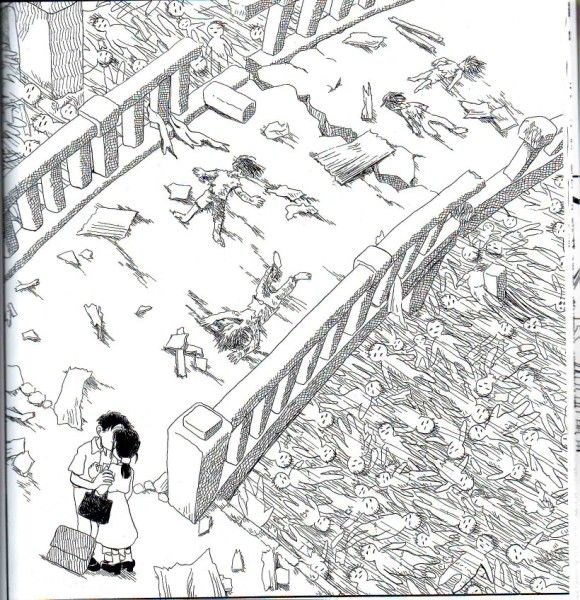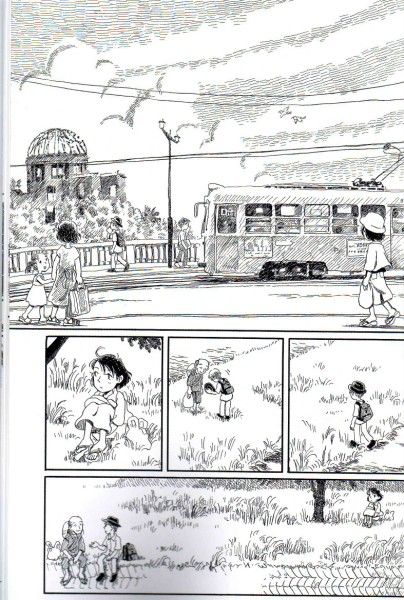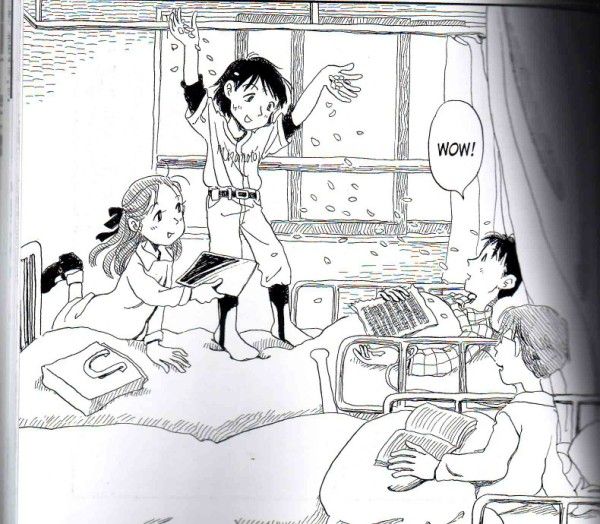As you can probably tell by the cover here Fumiyo Kouno's Town of Evening Calm, Country of Cherry Blossoms sprightly drawn shojo (girls) style manga about love, loss, the atomic bombing of Hiroshima, the lingering horrors of radiation sickness, and the subtle physical and mental wounds that span generations.
Or maybe you can't tell by the cover.
Danielle Leigh covered this book a while back in capsule form, but I had more to say.
Therefore all of us, here, now.
Also Leiden edited, leading to many comments like "Mr. Caps Lock is not your friend." Thanks, Leiden!
Technically, this 100 page volume contains two stories: Town of Evening Calm and Country of Cherry Blossoms but since they're connected through theme, characters, even setting, I found it easier to view 'em as two parts of a whole.
In order: Town of Evening Calm takes place ten years after the Hiroshima bombing. Our heroine is a teenage girl name Minami, who lives in the somewhat-rebuilt center of Hiroshima. And while Town of Evening Calm doesn't shy away from showing us Minamini's hard life - She sleeps in a one-room shack, next to her grandmother, she decides to walk barefoot to protect her shoes(!), and certainly can't afford a store-bought dress. Minami's certainly living in a tough environment, but the narrative isn't primarily concerned with survivor mentality - It's about the day to day acts of living, with THE BOMB a quiet, subtle shadow in the background. It's neither a happy story nor a downright horrible one either - Barring one scene where two lover's innocent embrace is portrayed against piles of faceless ghost-corpses in the backdrop, symbolizing both the epic struggle between life and death and the fairly subdued, introverted story about loving and losing that are the two major themes of the book.
Country of Cherry Blossoms, the second story, is even quieter, possibly because it's set even further from the tragedy. The rather ethereal plot concerns the evolving friendship between Nanimi Ishakawa, and her friend Tojo, and Nanimi's attempts to find out why her father is sneaking off into the city at night. We also meet Minami;s Brother Ashasi, who was mentioned in Town of Evening Calm as being sent to live with family. This is an even bigger story, covering well over a decade of time, but, like Town of Evening Calm, the plot is fairly skeletal: A girl hangs out with her friends sometimes, follows her father into town sometimes, thinks about falling in love sometimes, and this minimal action leaves us to infer the larger struggles occuring in the background.
I'm not an especially experienced Manga reader, but I can definitely see how this book is playing against type. It ain't Death Note. Topically, it covers some of the same ground as Nakazawa's epic Barefoot Gen. But where Barefoot Gen viscerally demonstrated the horrors of the atomic bomb, ToECCoCB only alludes. We know this terrible thing happened, and we see the damage still occurring years later. Also, while Barefoot Gen was plot driven, Town of Evening Clam is powered by an interesting dichotomy: It's writing about characters, and drawing about place.
However, when taken together, the two stories avoid pushing the explosions, the break-ups, the big events, and instead communicate the ebb and flow of history through character pieces, only quietly alluding to the bombing and other big events. Even when we're shown the death of a major character, we never see the body of her family's hysterics. There's one panel showing a few drops of blood, and then a sequence of pure white, showing nothing. And then the camers zooms back for a few last glances of Central Hiroshima, and we see a paper blowing in the wind, rising towards the sky. And Cut.
End Scene.
Maybe the most interesting and effective storytelling element here is Kouno's "characterization" of the city itself. As with the panels above, the camera ducks and waves, showing us both the characters and the city itself from a variety of angles, moving from extreme close-ups - Just a face - to lush, panoramic, cityscapes.
Rarely, we might catch a quick glimpse of a ruined building, but Hiroshima is usually teaming with life. Busses, run, neighbors greet each other in the street, dogs frolic, cherry blossoms grow. Kouno's people live in a fully realized world...
Which falls apart a little bit when we look past the scenery and concentrate on the nuts-and-bolts cartooning.
On the one hand, the cheerful cartoonishness that deliniates the happy-go-lucky lookin' little moppets provide a thematic contrast to the STORY about THE BOMB. On the other the figure drawing is so locked into Kouno's singular style that it fails to reinforce the interplay of multiple themes and moods that the story tries to conjure. In fact, in some places it actively hindered my following of the plot. I didn't notice, for instance, when the main characters aged 18 years between the first and second chapters, as they basically retained the same undefined, demeanor. There's a strange discepancy here. The art seems to be almost completely consumed with establishing place, the writing is all about defining character, and the two never really gel together into a seamless comic narrative.
Back to the writing: It's solidly paced and confident, allowing the reader to interact on his or her own level with the heavy shit being laid down, and not stooping to simplistic demonization... It shows the prejudice Japanese people demonstrated towards Hiroshima survivors, but it also shows the somewhat logical reasons FOR this prejudice - The survivors did tend to drop dead of radiation poisoning, and who the hell knows if it was catching? There are a handful of translation flubs where the dialog is non-naturalistic, or sometimes downright clunky, but the surety and graceful subtlety of the pacing and characterization greatly outweigh these couple hiccups.
It is a pretty damn good book, even if it doesn't quite seem like Fumiyo Kouno has hit her stride as a cartoonist, especially in terms of integrating art and text, and the art isn't quite up to the task of presenting the dark-night-of-the-soul-oh-shit-everbody-died themes of the book. Still, the strengths outweight the weaknesses, here, and this feels like an important, maybe even a necessary comic - The only way for old wounds to heal is to expose them to the light.





